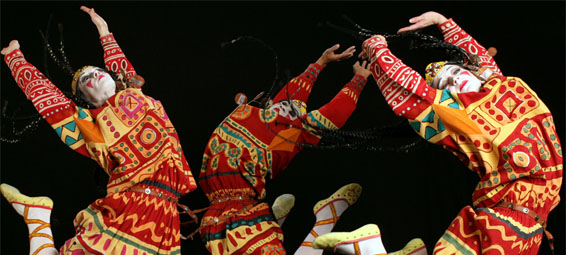It may have been 20 years since the internationally acclaimed Joffrey Ballet appeared live in Dallas Texas, but thanks to modern technology, keeping up with them has been as simple as going to the movies (The Company) or running a quick search on YouTube. Still, nothing quite makes up for the real thing, and so on Friday night, thanks to Charles Santos and TITAS, Joffrey Ballet presented a delightful cocktail of masterworks on the Winspear stage. The program, which included Vaslav Nijinsky’s Le Sacre du Printemps(1913) Edwaard Liang’s, Age of Innocence, (2008) and Christopher Wheeldon’s, After the Rain,(2005), illuminated both the origin of modernism in ballet side-by-side with current contemporary ballets.
The collection of ballets weren’t all perfect. Even the seasoned patron of ballet would be hard pressed to find clarity in the opening segment of Liang’s ballet, Age of Innocence. Thankfully, the rest of the ballet made up for that disaster. There were two terrific pas de deuxs, complete with intricate overhead lifts, generous leg extensions and fluid movement phrases that were surprisingly void of the classical poses and completely seamless in transition. Victoria Jaiani and Fabrice Calmels gave outstanding performance, and a powerful and technically difficult men’s section was delivered with fierce articulation and brute strength. The men ran onto the stage, sliding to a halt with their legs straight, feet apart, dropped to the ground in the shape of a swastika and manage to rebound to a standing position without using their arms to get up. It was choreographically brutal and effortlessly executed.
After The Rain premiered in 2005 with New York City Ballet and was danced by Wendy Whelan and Jock Soto. The ballet, set to Arvo Pärt’s Tabula Rasa and Spiegel im Spiegel, is in two sections: pas de six and pas de deux. For the second time this evening audiences were treated to a performance by Victoria Jaiani and Fabrice Calmels, and they were visually and emotionally breathtaking. It’s not surprising the duet has been performed as a standalone by several companies, including the Joffrey Ballet, Pacific Northwest Ballet, San Francisco Ballet, and The Australian Ballet.
The final performance of the evening would really need an 800 word essay of its own to properly pay homage to the living history experienced tonight. For the most part, the original works of the Ballets Russes are gone, with no films to verify their authenticity. There are virtually no participants or eyewitnesses left as you’d have to be over 80 to have seen a performance. Fortunately, in 1987, dance scholar Millicent Hodson and the Joffrey Ballet undertook the reconstruction of Le Sacre du Printemps, Vaslav’s Nijinsky’s tribute to pagan Russia, which originally premiere May 29, 1913 at the Theatre des Champs-Elysees in Paris. The post premier audience riot made it one of the most internationally well known and most controversial works in dance and music history.
The ballet is divided into two acts, “Adoration of the Earth” and “The Sacrifice.” From the hushed and unusually high bassoon opening to the savagery of the concluding “sacrifice”, audiences are transported to a world of ritual violence, fertility rites, and torment. This evening’s performance was layered with complex rhythmic patterns, colorful décor and costumes (after Nicholas Roerich, reconstructed and supervised by Kenneth Archer) and brilliantly executed choreography. Ripe with un-balletic inverted feet and a ménage of pedestrian movements (jumping, shuffling, sliding, knocking, etc.) one can understand how this ballet might have shocked audiences. That said, it’s truly impossible to see “Sacre” with the eyes of 1913. So, we must look through the lenses of 2013 modernism. What you’ll experience is a perfect amalgamation of visual art, dance, masterfully complex musical composition, and social commentary carefully constructed and gifted to you.






